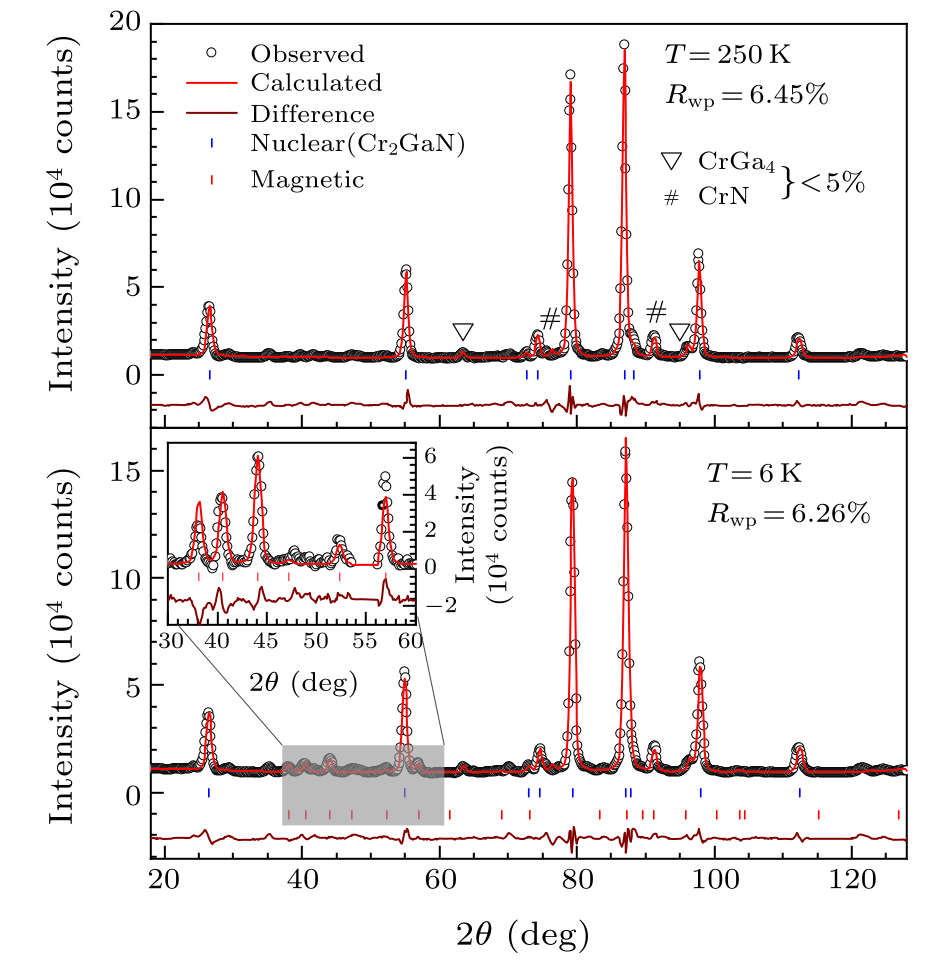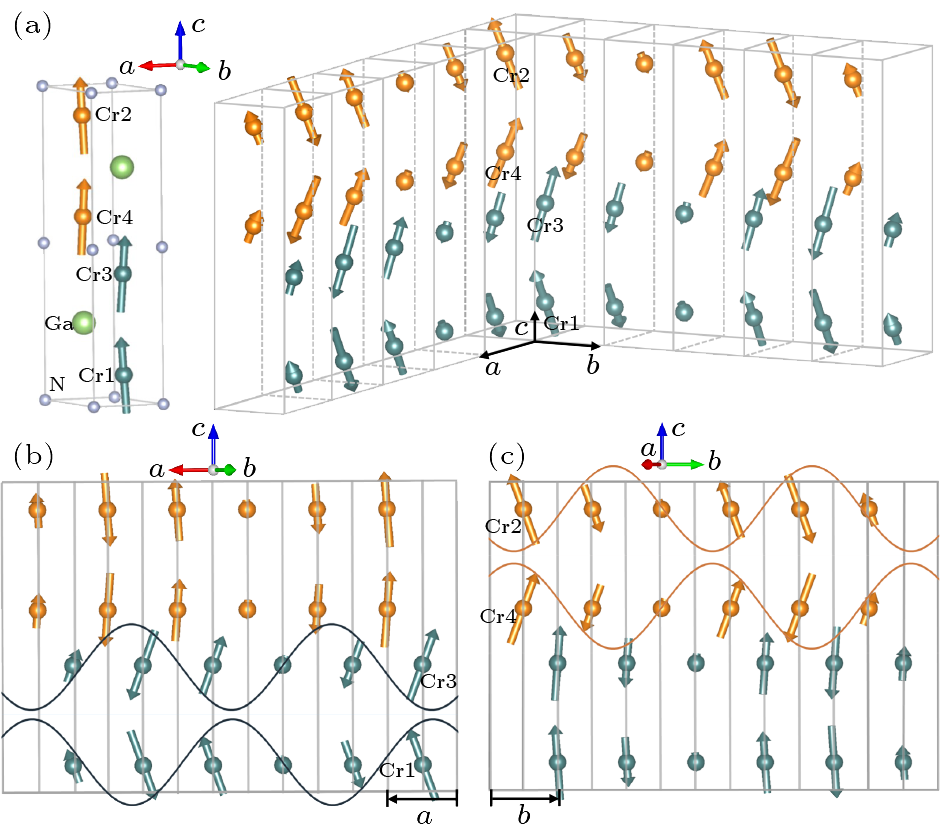



Fig. 1. The Rietveld refinement results with hexagonal phase $P6_3/mmc$ at (a) 250 K and (b) 6 K. The vertical blue lines represent the positions of the Bragg peaks in Cr$_2$GaN, red lines designate those of magnetic peaks, inverted triangle is the impurities of CrGa$_4$ and CrN. The inset in Fig. 1(b) gives a schematic show of the refinement of magnetic phase in the range of 2${\theta} \sim 35^{\circ}$–60$^{\circ}$.
| 250 K | 6 K | ||||
|---|---|---|---|---|---|
| Space group | $P6_3/mmc$ | $P6_3/mmc$ | |||
| $a$ (Å) | 2.861(5) | 2.850(1) | |||
| $c$ (Å) | 12.671(9) | 12.713(1) | |||
| $z_{_{\scriptstyle \rm Cr}}$ | 0.087(2) | 0.089(1) | |||
| B$_{\rm iso}$(Cr) (Å$^{2}$) | 1.118(2) | 0.350(1) | |||
| B$_{\rm iso}$(Ga) (Å$^{2}$) | 0.839(2) | 0.515(8) | |||
| B$_{\rm iso}$(N) (Å$^{2}$) | 1.112(6) | 0.960(8) | |||
| Atom | Wyckoff | $x$ | $y$ | $z$ | |
| Cr | $4f$ | 1/3 | 2/3 | $z_{_{\scriptstyle \rm Cr}}$ | |
| Ga | $2d$ | 1/3 | 2/3 | 0.75 | |
| N | $2a$ | 0 | 0 | 0 |

Fig. 2. (a) Three-dimensional sinusoidal modulated magnetic structure of Cr$_2$GaN at 6 K in single unit cell and supercell. Two-dimensional sinusoidal modulated magnetic structure of Cr$_2$GaN at 6 K along (b) $a$-axis and (c) $b$-axis.
| BV components | Positional coordinates | ||||||||||||
|---|---|---|---|---|---|---|---|---|---|---|---|---|---|
| IR | BV | Atom | $m_{||a}$ | $m_{||b}$ | $m_{||c}$ | $x$ | $y$ | $z$ | |||||
| $\varGamma_3$ | $\psi_7$ | 1 | 1 | 0 | 0 | $x$ | $y$ | $z$ | |||||
| 2 | 0 | $-1$ | 0 | ${\bar{x}}$+1 | ${\bar{y}}$+1 | ${\bar{z}}$+1 | |||||||
| 3 | $-1$ | 0 | 0 | $x$ | $y$ | ${\bar{z}}+1/2$ | |||||||
| 4 | 0 | 1 | 0 | ${\bar{x}}$+1 | ${\bar{y}}$+1 | $z+1/2$ | |||||||
| $\psi_8$ | 1 | 0 | 1 | 0 | $x$ | $y$ | $z$ | ||||||
| 2 | $-1$ | 0 | 0 | ${\bar{x}}$+1 | ${\bar{y}}$+1 | ${\bar{z}}$+1 | |||||||
| 3 | 0 | $-1$ | 0 | $x$ | $y$ | ${\bar{z}}+1/2$ | |||||||
| 4 | 1 | 0 | 0 | ${\bar{x}}$+1 | ${\bar{y}}$+1 | $z+1/2$ | |||||||
| $\psi_9$ | 1 | 0 | 0 | 1 | $x$ | $y$ | $z$ | ||||||
| 2 | 0 | 0 | 1 | ${\bar{x}}$+1 | ${\bar{y}}$+1 | ${\bar{z}}$+1 | |||||||
| 3 | 0 | 0 | 1 | $x$ | $y$ | ${\bar{z}}+1/2$ | |||||||
| 4 | 0 | 0 | 1 | ${\bar{x}}$+1 | ${\bar{y}}$+1 | $z+1/2$ | |||||||

Fig. 3. (a) The temperature-dependent nuclear peak (004) and magnetic peaks of (002)$_{\rm M} \pm k$, (000)$_{\rm M} \pm k$, (101)$_{\rm M}-k$, and (100)$_{\rm M}-k$. (b) Temperature dependence of the normalized intensity of magnetic peaks (000)$_{\rm M} \pm k$ and (101)$_{\rm M}-k$ and lattice constant $c$. The inset in Fig. 3(b) is the fitting of magnetic peaks at 10 K. For these magnetic peaks, the fits to Gauss function are performed for different temperatures, and the obtained area represent their intensity of magnetic peaks.
| [1] | Barsoum M W 2000 Prog. Solid State Chem. 28 201 | The MN+1AXN phases: A new class of solids
| [2] | Eklund P et al. 2010 Thin Solid Films 518 1851 | The M+1AX phases: Materials science and thin-film processing
| [3] | Sun Z M 2011 Int. Mater. Rev. 56 143 | Progress in research and development on MAX phases: a family of layered ternary compounds
| [4] | Barsoum M W et al. 2001 Am. Sci. 89 334 | The MAX Phases: Unique New Carbide and Nitride Materials
| [5] | Barsoum M W et al. 1996 J. Am. Ceram. Soc. 79 1953 | Synthesis and Characterization of a Remarkable Ceramic: Ti3SiC2
| [6] | Ingason A S, Dahlqvist M, and Rosen J 2016 J. Phys.: Condens. Matter 28 433003 | Magnetic MAX phases from theory and experiments; a review
| [7] | Novoselova I P et al. 2018 Sci. Rep. 8 2637 | Large uniaxial magnetostriction with sign inversion at the first order phase transition in the nanolaminated Mn2GaC MAX phase
| [8] | Dahlqvist M et al. 2016 Phys. Rev. B 93 014410 | Magnetically driven anisotropic structural changes in the atomic laminate
| [9] | Boucher R, Berger O, and Leyens C 2016 Surf. Eng. 32 172 | Magnetic properties of bulk and thin film Cr–Al–C compounds
| [10] | Salikhov R et al. 2015 Mater. Res. Lett. 3 156 | Magnetic Anisotropy in the (Cr0.5 Mn0.5 )2 GaC MAX Phase
| [11] | Liu Z, Waki T, Tabata Y, and Nakamura H 2014 Phys. Rev. B 89 054435 | Mn-doping-induced itinerant-electron ferromagnetism in GeC
| [12] | Li Y F, Liu J Z, Liu W H, Zhu X Y, and Wen H H 2015 Philos. Mag. 95 2831 | Suppression of a possible spin-density wave transition in Cr2 GaN by Ge doping
| [13] | Liu Z, Waki T, Tabata Y, Yuge K, Nakamura H, and Watanabe I 2013 Phys. Rev. B 88 134401 | Magnetic ground state of the -phase nitride Cr GaN
| [14] | Rietveld H M 1969 J. Appl. Crystallogr. 2 65 | A profile refinement method for nuclear and magnetic structures
| [15] | Rodríguez-Carvajal J 1993 Phys. B: Condens. Matter 192 55 | Recent advances in magnetic structure determination by neutron powder diffraction
| [16] | Wills A S 2000 Physica B 276–278 680 | A new protocol for the determination of magnetic structures using simulated annealing and representational analysis (SARAh)
| [17] | Ren Q Y, Hutchison W D, Wang J L, Studer A J, and Campbell S J 2018 Chem. Mater. 30 1324 | Magnetic and Structural Transitions Tuned through Valence Electron Concentration in Magnetocaloric Mn(Co 1– x Ni x )Ge
| [18] | Akito S et al. 2018 Nat. Phys. 14 1119 | Giant anomalous Nernst effect and quantum-critical scaling in a ferromagnetic semimetal
| [19] | Manna K et al. 2018 Phys. Rev. X 8 041045 | From Colossal to Zero: Controlling the Anomalous Hall Effect in Magnetic Heusler Compounds via Berry Curvature Design
| [20] | Guin S N et al. 2019 NPG Asia Mater. 11 16 | Anomalous Nernst effect beyond the magnetization scaling relation in the ferromagnetic Heusler compound Co2MnGa
| [21] | Vilanova V E, Stryganyuk G, Schneider H, Felser C, and Jakob G 2011 Appl. Phys. Lett. 99 132509 | Exploring Co2 MnAl Heusler compound for anomalous Hall effect sensors
| [22] | Li P G et al. 2020 Nat. Commun. 11 3476 | Giant room temperature anomalous Hall effect and tunable topology in a ferromagnetic topological semimetal Co2MnAl
| [23] | Chang G Q et al. 2016 Sci. Rep. 6 38839 | Room-temperature magnetic topological Weyl fermion and nodal line semimetal states in half-metallic Heusler Co2TiX (X=Si, Ge, or Sn)
| [24] | Wang Z J et al. 2016 Phys. Rev. Lett. 117 236401 | Time-Reversal-Breaking Weyl Fermions in Magnetic Heusler Alloys
| [25] | Liu C et al. 2021 Sci. Chin. Phys. Mech. & Astron. 64 217062 | Spin excitations and spin wave gap in the ferromagnetic Weyl semimetal Co3Sn2S2
| [26] | Liu C et al. 2021 Sci. Chin. Phys. Mech. & Astron. 64 257511 | Anisotropic magnetoelastic response in the magnetic Weyl semimetal Co3Sn2S2
| [27] | Itoh S et al. 2016 Nat. Commun. 7 11788 | Weyl fermions and spin dynamics of metallic ferromagnet SrRuO3
| [28] | Jenni K et al. 2019 Phys. Rev. Lett. 123 017202 | Interplay of Electronic and Spin Degrees in Ferromagnetic : Anomalous Softening of the Magnon Gap and Stiffness
| [29] | Xu Y F et al. 2020 Nature 586 702 | High-throughput calculations of magnetic topological materials
| [30] | Wang P Y, Ge J, Li J H, Liu Y Z, Xu Y, and Wang J 2021 Innovation 2 100098 | Intrinsic magnetic topological insulators
| [31] | Bernevig B A, Felser C, and Beidenkopf H 2022 Nature 603 41 | Progress and prospects in magnetic topological materials
| [32] | Wang H et al. 2020 Sci. Chin. Phys. Mech. & Astron. 63 287411 | Investigation of point-contact Andreev reflection on magnetic Weyl semimetal Co3Sn2S2
| [33] | Xie X C 2021 Sci. Chin. Phys. Mech. & Astron. 64 217061 | Spin waves in magnetic Weyl semimetals
| [34] | Yan B H 2021 Sci. Chin. Phys. Mech. & Astron. 64 217063 | Weyl monopoles dance with the spin waves
| [35] | Cai Z W et al. 2020 Phys. Rev. B 104 L020402 | Topological magnon insulator spin excitations in the two-dimensional ferromagnet
| [36] | Li J, Feng J S, Wang P S, Kan E J, and Xiang H J 2021 Sci. Chin. Phys. Mech. & Astron. 64 286811 | Nature of spin-lattice coupling in two-dimensional CrI3 and CrGeTe3